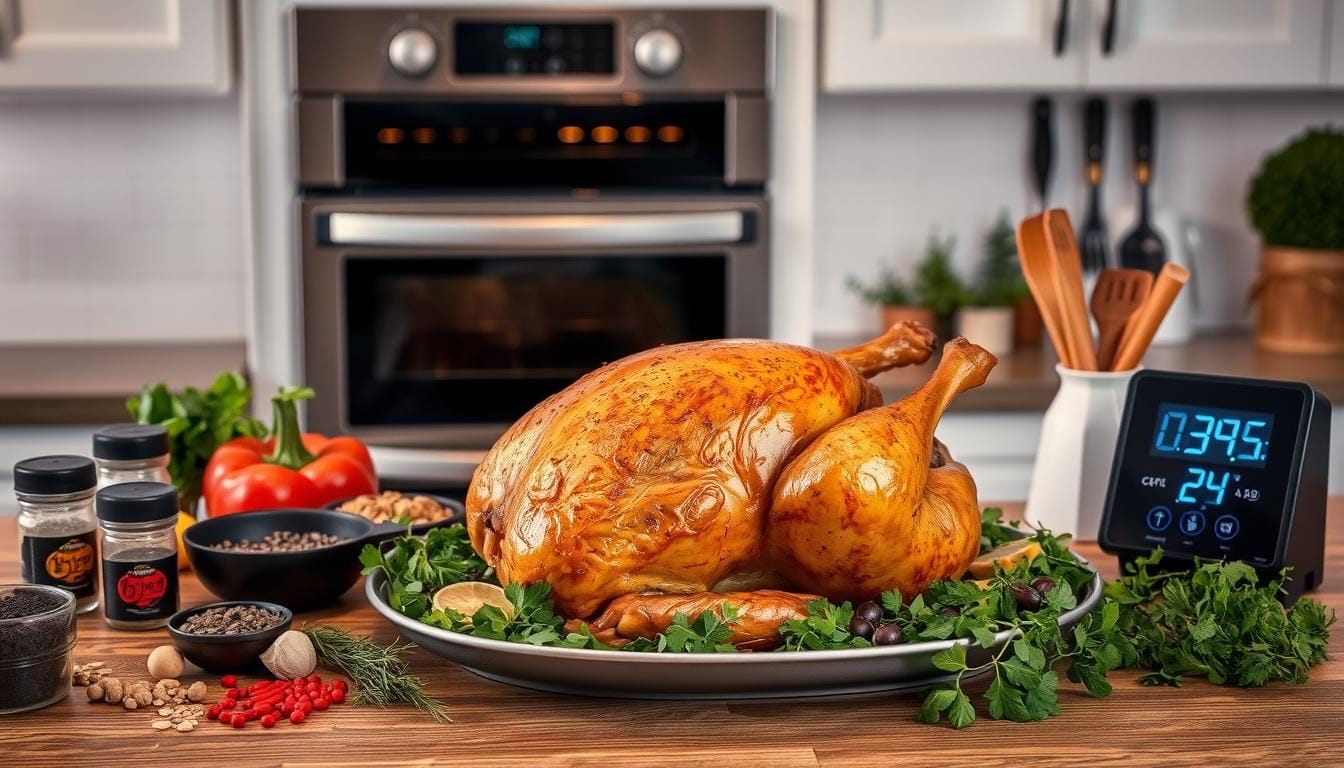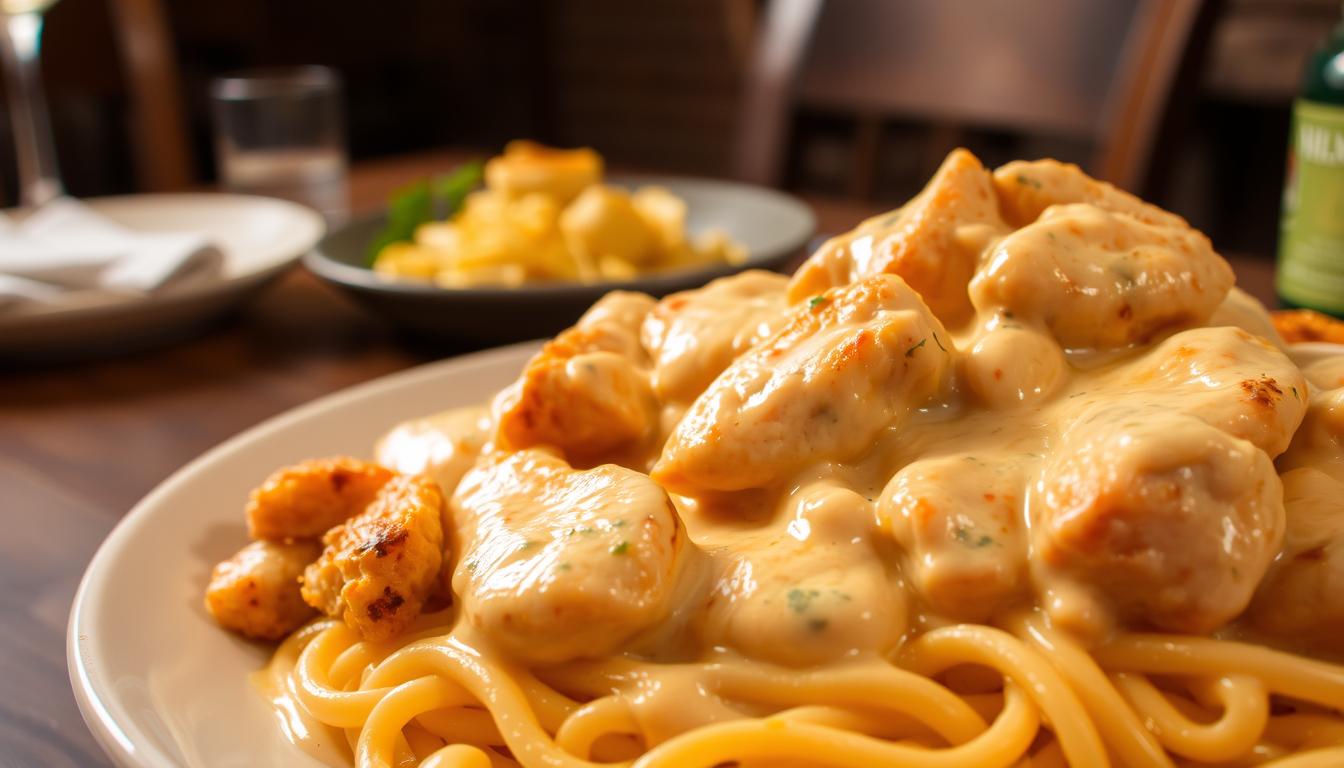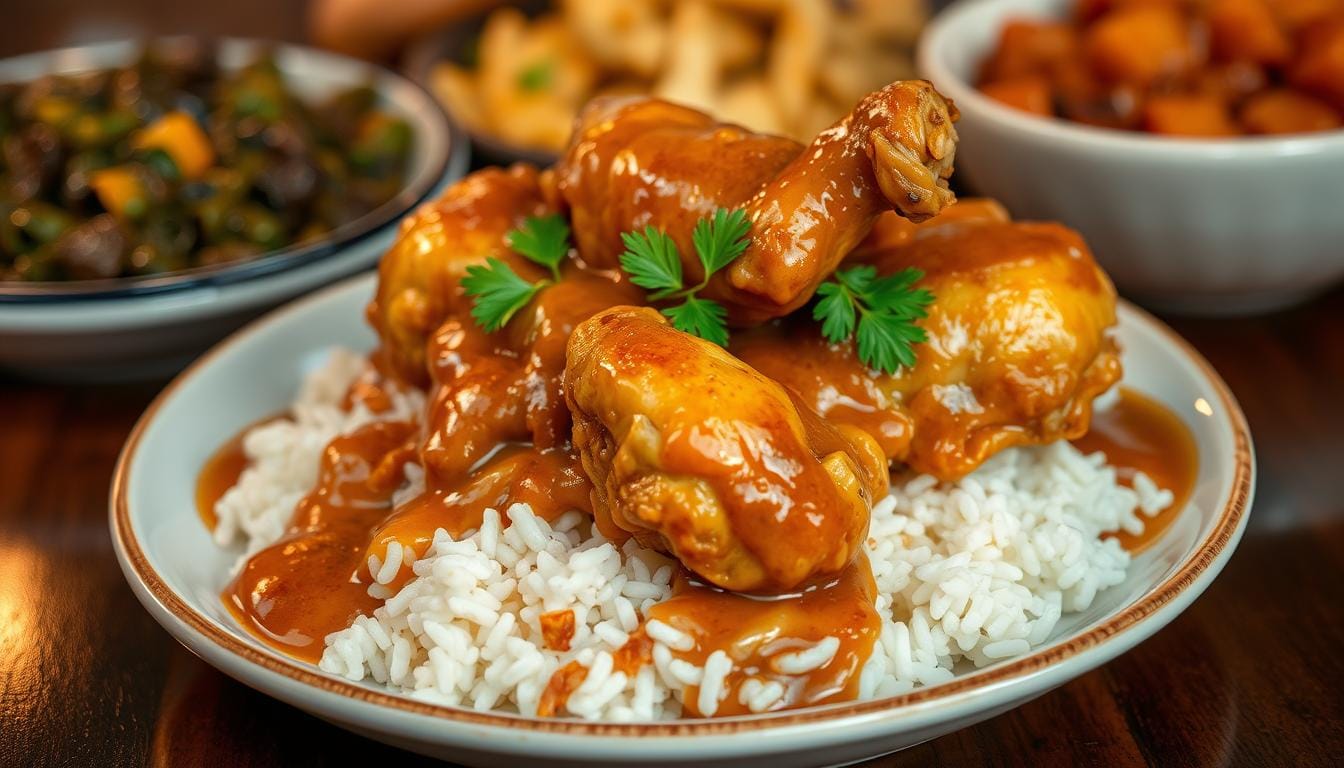Turkey Cook Time in Oven might seem scary, but it’s easier than you think. With the right tips on turkey cook time, you’ll make a beautiful holiday dish. This guide is for both new cooks and experienced chefs, helping you feel confident in the kitchen.
To make the perfect turkey, you need to know about weight, stuffing, and cooking temperatures. Many people worry about cooking a turkey, but it’s simpler than it seems. Just break it down into easy steps.
The secret to a great turkey is preparation. You’ll learn how to pick the right turkey size and cooking times. This guide will teach you how to make a delicious, safe turkey that will wow your guests.
Table of Contents
Key Takeaways
- Cooking times vary based on turkey weight and whether it’s stuffed
- Always use a meat thermometer to ensure safe internal temperature
- Plan ahead for proper thawing and preparation
- Different turkey sizes require different cooking approaches
- Resting the turkey after cooking is crucial for juicy meat
- Proper seasoning and brining can enhance flavor and moisture
Understanding Turkey Cooking Basics
Getting your turkey just right is more than just tossing it in the oven. It’s about picking the right tools, choosing the right turkey size, and thawing it safely.
Essential Equipment for Turkey Roasting
First, make sure you have these key items:
- Large roasting pan with a rack
- Reliable meat thermometer
- Kitchen twine
- Aluminum foil
- Basting brush
Choosing the Right Size Turkey
Picking the right turkey size is key so everyone gets enough. The oven temperature needed depends on the turkey’s weight. Here’s a guide to help you choose:
| Number of Guests | Turkey Weight |
|---|---|
| 4-6 people | 8-12 pounds |
| 8-10 people | 12-15 pounds |
| 12-16 people | 16-20 pounds |
Thawing Guidelines and Safety
Thawing your turkey right is key for food safety. Here’s how to start with thawing:
- Refrigerator thawing takes about 24 hours for every 4-5 pounds
- A 15-pound turkey needs about 3 days to thaw fully
- Never thaw turkey at room temperature
- Put turkey in a container to catch drips
“Safety first: Always ensure your turkey is completely thawed before cooking to guarantee even roasting and prevent bacterial growth.” – USDA Food Safety Guidelines
Learning these basics is the first step to a delicious, perfectly cooked turkey. It will impress your guests and make your meal safe and fun.
Turkey Cook Time in Oven: Complete Time Chart
Learning how to cook a turkey in the oven is key for a great holiday meal. The cooking time depends on the turkey’s weight, if it’s stuffed, and your oven’s temperature.
“The key to a delicious turkey is precise cooking time and temperature control.”
Knowing how long to cook a turkey per pound can make a big difference. It can turn a dry, tough bird into a juicy, succulent centerpiece.
Cooking Time Guidelines
| Turkey Weight | Unstuffed Cooking Time | Stuffed Cooking Time |
|---|---|---|
| 8-12 pounds | 2¾ to 3 hours | 3 to 3½ hours |
| 12-14 pounds | 3 to 3¾ hours | 3½ to 4 hours |
| 14-18 pounds | 3¾ to 4¼ hours | 4 to 4¼ hours |
| 18-20 pounds | 4¼ to 4½ hours | 4¼ to 4¾ hours |
| 20-24 pounds | 4½ to 5 hours | 4¾ to 5¼ hours |
Here are some key tips for cooking a turkey in the oven:
- Always cook at 325°F for consistent results
- Use a meat thermometer to check internal temperature
- Aim for 165°F in the thickest part of the thigh
- Let the turkey rest 15-20 minutes after cooking
Pro tip: Cooking times are guidelines. Individual ovens vary, so always use temperature as your primary doneness indicator.
Preparing Your Turkey for Roasting
Getting your turkey ready for the oven is key to a delicious turkey roast. The right steps can turn an ordinary bird into a memorable meal. It’s sure to impress your guests.
Brining: Unlocking Maximum Flavor
Brining is a game-changer for oven-cooked turkey. You have two main methods:
- Wet Brining: Soak the turkey in a saltwater solution for 12-24 hours
- Dry Brining: Rub salt on the turkey’s skin 1-2 days before cooking
“Brining is the secret weapon for achieving a moist and flavorful turkey every time!”
Seasoning Like a Pro
Seasoning is crucial for a delicious turkey roast. Use fresh herbs and spices to create a robust flavor:
- Choose fresh herbs like rosemary, thyme, and sage
- Add garlic and onion powders
- Use kosher salt and black pepper generously
Stuffing Considerations
Choosing whether to stuff your turkey is important. Stuffing inside can make cooking longer and risk food safety.
| Stuffing Method | Pros | Cons |
|---|---|---|
| Inside Turkey | Traditional flavor absorption | Longer cooking time, potential food safety risks |
| Outside Turkey | Faster cooking, safer preparation | Less direct flavor infusion |
Pro tip: Stuffing inside the turkey should reach 165°F for safe eating.
Perfect Temperature Settings for Roasting Turkey
Choosing the right temperature for roasting turkey is key to a delicious bird. The oven temperature needed depends on your cooking method and desired outcome.
Professional chefs suggest a smart approach to turkey roasting temperatures:
- Start with a high initial temperature of 425°F
- Reduce to 350°F after 30-45 minutes
- Maintain a consistent temperature for even cooking
“The key to a perfect turkey is mastering temperature control” – Culinary Experts
Here’s a detailed breakdown of recommended oven temperatures:
| Cooking Method | Recommended Temperature | Cooking Time Estimate |
|---|---|---|
| Classic Roasting | 350°F | 13-15 minutes per pound |
| Convection Roasting | 325°F | 10-12 minutes per pound |
| Smoked Turkey | 325-350°F | 30-40 minutes per pound |
The ultimate goal is to reach an internal temperature of 165°F for safety. Use a meat thermometer to check the turkey’s doneness. Insert it into the thickest part of the thigh, avoiding the bone.
Professional tip: Let your turkey rest for at least 25 minutes after cooking. This ensures juicy, tender meat. The internal temperature will rise slightly during this time.
Essential Steps for Achieving Golden-Brown Skin
Getting your turkey skin golden brown is an art. The right steps can turn your turkey into a showstopper. Your holiday meal will be unforgettable.
For crispy turkey skin, pay close attention to your oven cooking. You want a skin that looks great and tastes amazing.
Mastering Basting Techniques
Basting is key to a better turkey. Here are some tips:
- Baste every 30 minutes with pan drippings
- Use a turkey baster or large spoon for even coverage
- Minimize oven door openings to maintain consistent temperature
Temperature Control for Perfect Skin
Temperature is everything for golden skin. Start at 325°F and follow these steps:
- Preheat your oven thoroughly
- Use aluminum foil to prevent over-browning
- Increase temperature during final 30 minutes for crispy skin
“The secret to perfect turkey skin is patience and precise temperature control.” – Professional Chef
With these tips, your turkey will have skin that’s crispy and golden. It will impress everyone and make your turkey recipe a hit.
Monitoring Turkey Doneness and Safety
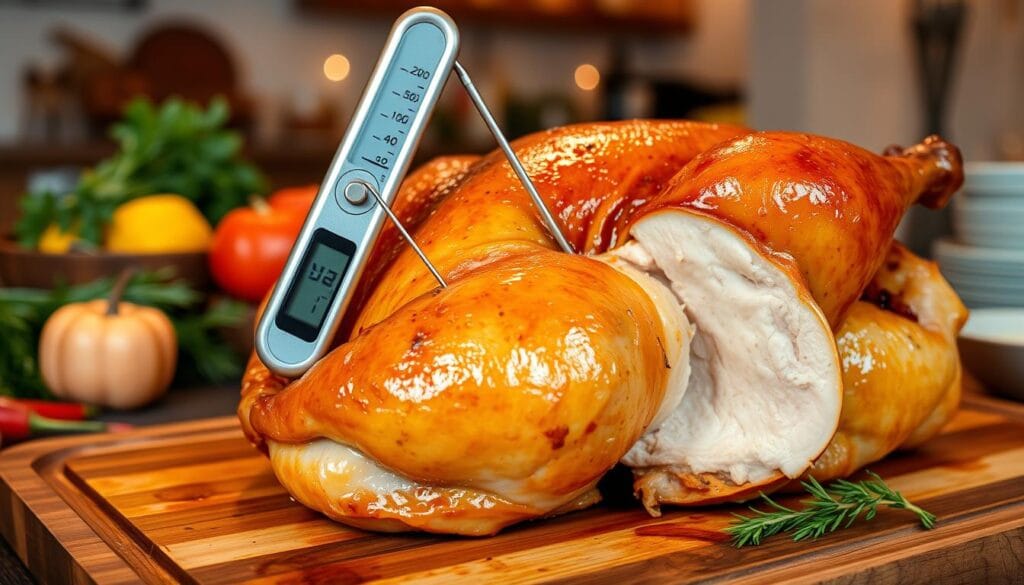
It’s key to make sure your turkey is cooked just right. This is important for both safety and taste. When you’re roasting a turkey in the oven, checking the internal temperature is the most important step.
“Temperature is the ultimate indicator of turkey doneness, not cooking time.” – Culinary Experts
To cook a turkey perfectly, you need to watch the temperature closely. Use a good meat thermometer to check the turkey’s internal temperature. Do this at the thickest parts of the turkey.
- Insert thermometer into thigh, avoiding bone
- Check breast meat at its thickest point
- Verify stuffing temperature if applicable
It’s important to follow safety guidelines to avoid bacterial risks. Here’s a quick guide for safe cooking temperatures:
| Turkey Part | Safe Temperature | Cooking Recommendation |
|---|---|---|
| Breast | 165°F (74°C) | Instant bacteria elimination |
| Thigh | 175°F (79°C) | Optimal moisture retention |
| Stuffing | 165°F (74°C) | Ensure complete cooking |
Don’t forget about carry-over cooking after taking the turkey out of the oven. Let it rest for 15-20 minutes. This helps the juices spread out, making the turkey moist and tasty.
Pro tip: Ovens can vary in temperature by 25-50°F. Always use your meat thermometer for the most accurate reading.
Professional Tips for Moist and Tender Meat
To make a delicious turkey roast in the oven, you need more than basic steps. Professional chefs share secrets for a moist, tender turkey. This will impress your guests and make your turkey recipe a hit.
The secret to keeping meat moist is knowing key techniques. These methods protect the meat’s tenderness while it cooks.
Breast Protection Techniques
Keeping the turkey breast juicy is key. Here are some pro tips:
- Cover the breast with butter-soaked cheesecloth
- Use aluminum foil to shield the most delicate parts
- Roast the turkey breast-side down for the first hour to redistribute juices
Resting Period Guidelines
The resting period is often missed but it’s crucial. After taking the turkey out of the oven, let it rest for 20-30 minutes. This step is important for:
- Juice redistribution throughout the meat
- Temperature equalization
- More tender and flavorful slices
“Patience is the secret ingredient in creating the perfect roasted turkey.” – Professional Chef’s Wisdom
Remember, patience during the resting period can turn a good turkey into an amazing meal. Follow these tips for a delicious turkey roast.
Common Turkey Roasting Mistakes to Avoid
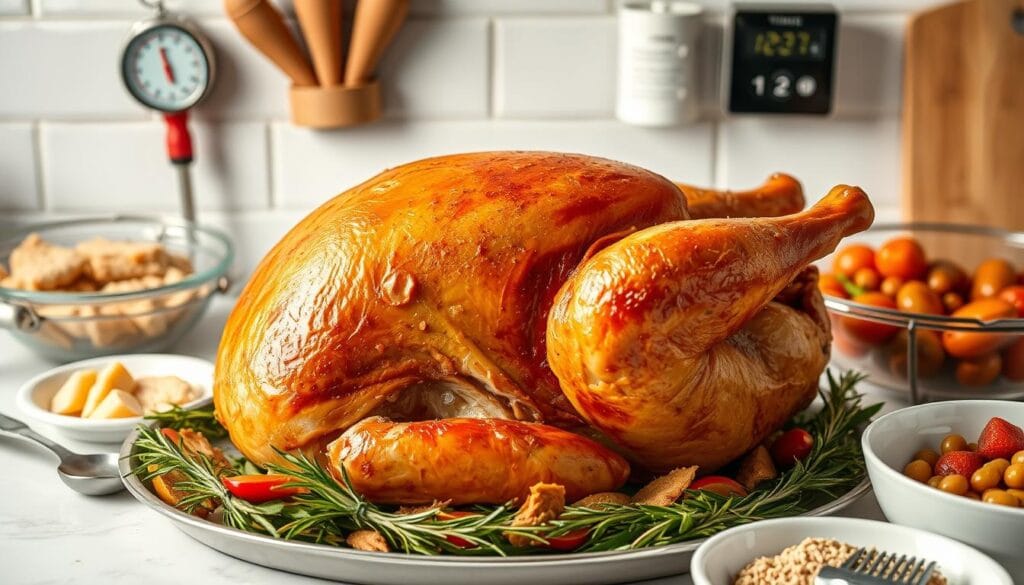
Cooking a turkey in the oven can be tricky. Knowing the common mistakes can help you avoid ruining your holiday meal. A good guide to roasting a turkey in the oven can make all the difference.
“Precision is the key to perfect turkey roasting” – Professional Chef
Here are the most frequent turkey roasting errors to watch out for:
- Skipping the Meat Thermometer: About 40% of home cooks roast turkey without a thermometer, risking undercooked or dry meat.
- Cooking a Cold Turkey: Never place a refrigerator-cold bird directly into the oven. Let it reach room temperature first.
- Incorrect Temperature Settings: Only 30% of cooks use the recommended 13-15 minutes per pound at 325°F.
- Not Allowing Proper Resting Time: 24% of cooks carve immediately, causing moisture loss.
Your turkey’s success depends on careful preparation. Avoid washing the raw turkey, as this can spread harmful bacteria. Brining can enhance flavor, yet only 15% of turkey fans utilize this technique.
Critical temperature guidelines for safe cooking include:
- Reach an internal temperature of 165°F (73.9°C)
- Rest the turkey for 20-30 minutes before carving
- Check temperature in the thickest part of the thigh
By understanding these tips for cooking a turkey in the oven, you’ll dramatically improve your chances of serving a delicious, safely prepared centerpiece.
Special Techniques for Large and Small Turkeys
Cooking a turkey needs different methods based on its size. Whether it’s a small family dinner or a big holiday meal, knowing how to cook a turkey is key for great results.
Small Turkey Strategies
For turkeys between 5-10 pounds, you need to be precise. An eight-pound turkey can feed up to six people. It usually takes about 20 minutes per pound in the oven. The goal is to keep it moist and ensure it’s safe to eat.
- Cooking time: Approximately 2-3 hours
- Temperature: Keep it at 350°F
- Internal temperature goal: 165°F
Large Turkey Techniques
Bigger turkeys need extra care when figuring out cooking time. Spatchcocking is a great method for even cooking. It can cut cooking time by at least an hour and helps with heat distribution.
“Spatchcocking transforms turkey roasting from challenging to manageable” – Professional Chef
| Turkey Size | Cooking Time per Pound | Total Estimated Cooking Time |
|---|---|---|
| 5-8 pounds | 20 minutes | 2-3 hours |
| 10-14 pounds | 15 minutes | 3-4 hours |
| 15-20 pounds | 13 minutes | 4-5 hours |
Remember, no matter the size, always use a meat thermometer. Let the turkey rest for 20-30 minutes after cooking. And never skip reaching that 165°F internal temperature.
Pro Tips for Perfect Roasting
- Start with high heat (400-425°F) for the first 20 minutes
- Reduce temperature to 350°F for the rest of the time
- Baste or brush with butter for a golden, crispy skin
By using these size-specific techniques, you can turn your turkey into a juicy and unforgettable dish.
Conclusion
Learning to cook a perfect turkey in the oven is an art. It needs precision, skill, and love. In this guide, you’ve picked up key tips for a tasty turkey roast. It’s sure to wow your guests and make your holiday meal special.
To get a juicy turkey, it’s not just about following steps. Your meat thermometer is key. It makes sure the turkey’s inside is at 165°F (74°C). The oven cooking tips you’ve got stress the need for careful prep, watching the temperature, and letting it rest.
Every turkey is different, so feel free to try new things. Whether you’re cooking a small 10-pound turkey or a big 20-pound one, the basics stay the same. Thaw it right, season it well, watch the temperature, and let it rest before carving. With time and practice, you’ll make a turkey that’s unforgettable and delicious.
FAQ
How long should I cook a turkey in the oven?
What is the best temperature for roasting a turkey?
How do I know when my turkey is fully cooked?
Should I stuff my turkey before roasting?
How long does it take to thaw a frozen turkey?
How can I keep my turkey moist while roasting?
Can I cook a turkey from frozen?
How do I get crispy skin on my turkey?
Source Links
- How to Roast A Turkey the Easy Way – Fearless Fresh – https://fearlessfresh.com/how-to-roast-a-turkey/
- How Long to Cook a 14-Pound Turkey: Your Ultimate Guide – https://medium.com/@malokaadvocate/how-long-to-cook-a-14-pound-turkey-your-ultimate-guide-243529b93424
- 4 Ways to Cook Turkey Breast for Always-Juicy Results, According to Our Test Kitchen – https://www.bhg.com/recipes/how-to/handling-meat/how-to-cook-turkey-breast/
- My Mom’s Roast Turkey Always Delivers – https://www.simplyrecipes.com/recipes/moms_roast_turkey/
- How Long To Cook A Turkey: A Pound-By-Pound Guide – https://www.southernliving.com/holidays-occasions/thanksgiving/turkey-cooking-time-per-pound?srsltid=AfmBOopQfrweiYvPrnnN4pZqT652nFe1qLvhSiGjGJCychaKA3CGyQC0
- How Long to Cook a Turkey – https://www.wellplated.com/how-long-to-cook-a-turkey/
- How Long to Cook a Turkey, in One Easy Chart – https://www.realsimple.com/food-recipes/recipe-collections-favorites/seasonal/how-long-to-cook-a-turkey
- How Long to Cook Every Size Turkey—Whether Roasting, Smoking, or Deep Frying – https://www.marthastewart.com/8300433/how-long-to-cook-a-turkey
- Ree’s Roasted Thanksgiving Turkey Is the Best You’ll Ever Try – https://www.thepioneerwoman.com/food-cooking/recipes/a11883/roasted-thanksgiving-turkey/
- Best Roasted Turkey We’ve Ever Made – https://www.inspiredtaste.net/63746/roast-turkey/
- How Long to Cook a Turkey – https://www.allrecipes.com/article/turkey-cooking-time-guide/
- Here’s What Temperature to Cook a Turkey So It Stays Moist – https://www.realsimple.com/what-temperature-to-cook-a-turkey-6822735
- We Made a Chart That Shows You How Long to Cook Any Size Turkey – https://www.goodhousekeeping.com/holidays/thanksgiving-ideas/a33957409/how-long-to-cook-a-turkey/
- Thanksgiving Turkey – https://www.wellplated.com/how-to-cook-a-turkey/
- How to Roast a Turkey – https://www.jocooks.com/recipes/roast-turkey-2/
- The Perfect Thanksgiving Turkey | Your Local Butcher Tips – https://fraziesmeatandmarket.com/preparing-the-perfect-thanksgiving-turkey/
- Easy Roast Turkey Recipe – https://addapinch.com/roast-turkey-recipe/
- How to Cook a Turkey: Turkey Temperature & Doneness – https://blog.thermoworks.com/tips/turkey-temps/
- How to Check If Your Turkey’s Cooked to the Right Temperature – https://www.seriouseats.com/how-to-take-the-temperature-of-your-turkey-video
- I Tested This Thanksgiving Roast Turkey Recipe 7 Times So You Can Get It Perfect In 1 – https://www.delish.com/cooking/recipe-ideas/a62876155/best-roasted-turkey-recipe/
- Oven Roasted Turkey Breast—The Easy Way – https://www.101cookingfortwo.com/how-to-roast-a-turkey-breast-the-easy-way/
- High-Heat Roast Turkey – https://www.bettycrocker.com/recipes/high-heat-roast-turkey/99840653-3a49-43ad-85b7-184d1021305e
- How to Cook a Thanksgiving Turkey | Reynolds Brands – https://www.reynoldsbrands.com/tips-and-how-tos/how-cook-thanksgiving-turkey
- Follow This Easy Thanksgiving Turkey Cooking Guide for Any Size Bird – https://www.countryliving.com/food-drinks/a29762210/how-long-to-cook-turkey/
- Hosting an Intimate Thanksgiving? Here’s How to Cook a Small Turkey – https://www.realsimple.com/food-recipes/cooking-tips-techniques/how-to-cook-smaller-turkey
- 8 Completely Delicious Ways to Cook a Turkey, From Traditional Roast to Modern Roulade – https://www.marthastewart.com/ways-to-cook-turkey-8746802
- How To Roast Turkey Perfectly – https://cookthestory.com/how-to-roast-turkey-perfectly/
- How Long To Cook A Turkey: A Pound-By-Pound Guide – https://www.southernliving.com/holidays-occasions/thanksgiving/turkey-cooking-time-per-pound?srsltid=AfmBOooXdLqClEVDTPeH9FlSBAA7EnGagGCzgC0NOsOYk3TWuW6-3Rxx

